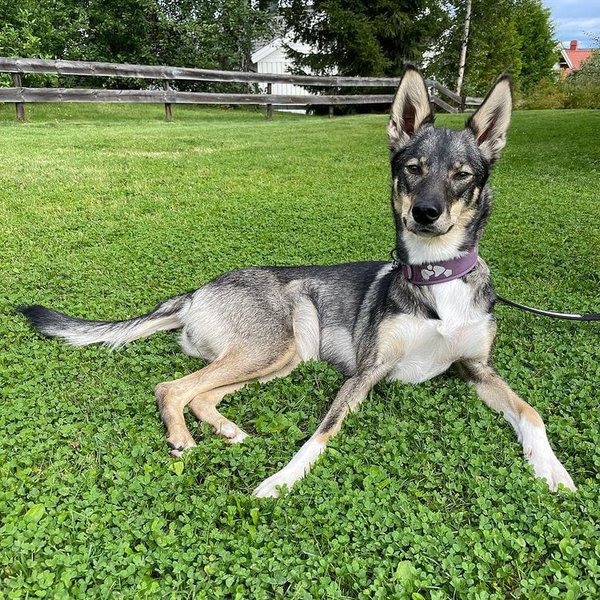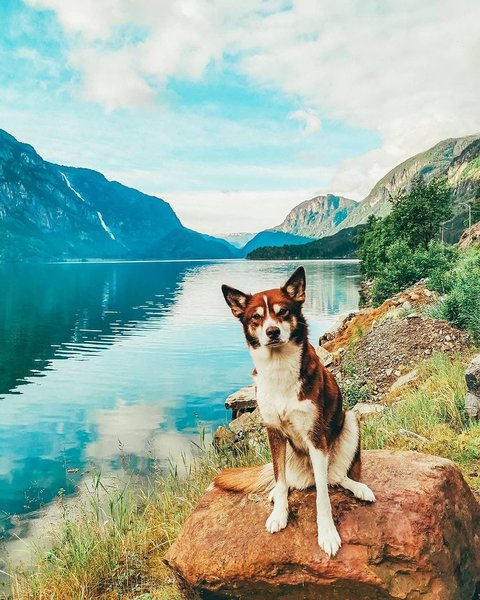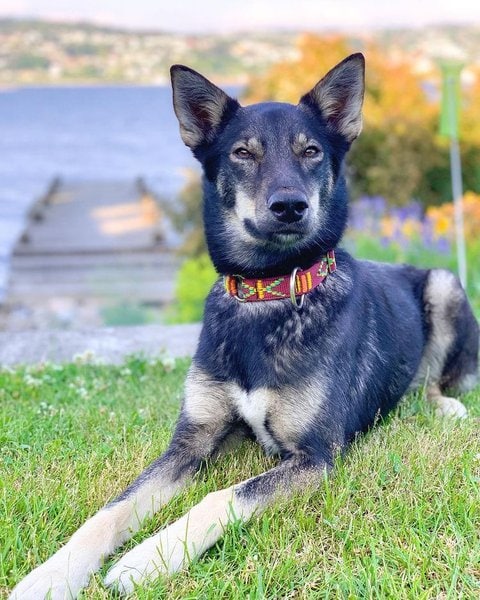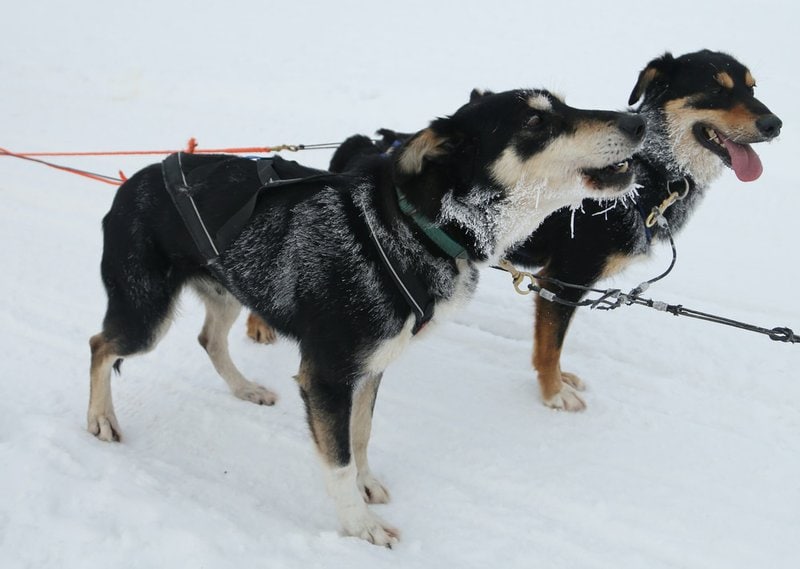This furry companion is an amazing athletic dog breed that was crossed between a few similar yet discrete breeds. Your canine buddy belongs to the same family as the Siberian Husky and Alaskan Malamute. While Alaskan Huskies share looks and other physical aspects with such breeds, their character differs.
When we hear the words “Alaskan Husky,” the first thing we think about is either the Alaskan Malamute or the Siberian Husky. Although many tend to confuse these breeds, we know that Alaskan Huskies are an athletic sled dog breed that is an “impure breed.” So, your Alaskan Husky doesn’t make it to the Kennel Club list.
This article is a complete breed guide if you’re looking forward to caring for an Alaskan Husky. Next, we’ll take a look at personality, physical characteristics, temperament, as well as puppy sale prices. Let’s get started with specifics on their size.
How Big Do Alaskan Huskies Get?

This athletic work doggie usually has a lean body, pointy wolflike ears, brown eyes, a deep chest, and long legs. The long legs are important because they define the purpose of the Alaskan Husky: running and pulling sleds.
Most Alaskan Husky dogs look like an interbreed between Alaskan Malamutes and Siberian Huskies. Some tend to inherit the wolf-like features, while others combine the looks of several mixed breeds.
A fully grown Alaskan Husky can achieve a height between 20 and 24 inches and a weight between 40 and 60 lbs.
Eyes
Most Alaskan Huskies, however, have brown eyes compared to Siberian Huskies that usually have blue eyes, though some Siberian Huskies have brown eyes or even a combination with one blue eye and one brown eye.
Coat Colors And Patterns
When choosing your Alaskan Husky, you can choose from a wide range of colors. Your four-legged furry friend could be gray, white, or black, depending on your color preference.
This furry friend’s coat is usually somewhere between short- and medium-length with a heavy undercoat that enhances their survival in cold temperatures.
Are Alaskan Huskies Purebred?
As a result of crossbreeding between the Greyhound, Siberian Husky, and other Nordic breeds, Alaskan Huskies are not purebred.
This doggie was first bred to work as a sled dog in Alaskan villages. This led to continued breeding and further reproduction.
How Long Do Alaskan Huskies Live?

Generally, you can spend around 12 to 15 years with your Alaskan Husky before you bid them goodbye.
Like other purebred dogs out there, this doggie can contract health problems, especially genetic defects. The Alaskan Husky, which is usually known for its health status, can become ill as it grows old.
Common Health Problems
Common health problems include progressive retinal atrophy (PRA), hip dysplasia, and hypothyroidism. The crossbred dog can also experience genetic defects that end up making your canine buddy blind.
Our furry sled dog is also prone to larynx deformation which can result in wheezing as the dog breathes. This explains the root of their popular Alaskan nickname, the Wheezer.
Can Alaskan Huskies Survive In Hot Weather?
Absolutely, these furry sled dogs can live not only in cold weather but also in hot weather.
Alaskan Huskies are well known for their adaptability since they can tolerate cold temperatures below 70 °F on the one hand and hot temperatures in tropical regions on the other hand.
However, remember that your furry friend naturally adapts to live in cold weather. Therefore, if you live in a hot weather climatic region, keep an eye on your doggie to protect from overheating, overexertion, and, most commonly, dehydration.
This means that you don’t need snow to care for your fluffy friend if you look out for their temperature levels, especially during hot days and their overall health.
How To Take Care Of Your Alaskan Husky?
Here are some tips to get you started on providing the right care for your Alaskan Husky.
Exercise Routine
The Alaskan Husky was naturally bred to produce a working dog to pull sleds, so they can cover long distances running. Their unmatched stamina and endurance levels make them appropriate for the task. Therefore, we advise you to keep your canine’s exercise routine to running to ensure they are physically fit.
Mental and physical fitness in dogs helps them stay calm and peaceful, minimizing misbehavior. You should spare at least an hour a day for this athletic fluffy dog for physical training. Apart from just walks, you can engage your canine buddy in athletic and sporty exercises such as running around the yard, hiking sessions, and other strenuous but interesting activities.
We, however, recommend you train your dogs when they are still young. You may be surprised to realize that Alaskan Huskies can be stubborn as well. So, you shouldn’t let them grow up to six months old without introducing exercise.
Alaskan Huskies’ Diet And Nutrition
The most basic thing to consider when planning to own a dog for the first time is to make sure you can feed your four-legged friend. All owners should consider buying the highest quality feeds that will certainly meet your canine’s food and nutrition needs.
Multivitamins
When it comes to feeding Huskies, the owners tend to wonder whether they should add supplements to their canine meals or not. In this case, we’ll advise you to first inquire from the veterinarian.

Invest In High-Quality Dog Food And Dental Water Additives
Pet Plate’s vet-designed meals are manufactured following safety standards like those used in human food production. Their recipes will help meet your Alaskan Husky’s nutrition needs.
We also advise that you buy and use dental water additives for your dog (dog mouthwash) to keep your furry friend’s mouth clean and fresh.
Are Alaskan Huskies Aggressive? Temperaments Of Alaskan Huskies
Instead of aggressive, Alaskan Huskies are friendly and highly sociable dogs since they’re adapted to be sled dogs and grow up in multi-pet homes.
They can be super active if you raise them in an active home. The pooch’s energy abundance makes them eager to engage in physical activities and exercises.
Are Alaskan Huskies Easy To Train?
Some owners experience difficult times housebreaking their Huskies since Huskies can be naturally clever and mischievous as well.
It is advised that you commence the housebreaking during their puppyhood or early months to make the learning and training processes easier.
Alaskan Huskies are such sociable canines that even strangers can head up to them to pet their heads. They barely bark like other dogs, but they can express themselves by howling.

Are Alaskan Huskies The Best Family Dogs?
Alaskan Huskies are naturally adventurous and independent dogs, but they have an undefined affection for their family. They are popularly known for their gentleness, especially towards kids.
Why Do Alaskan Huskies Talk?
If you own an Alaskan Husky, you know that Huskies tend to “talk” to their owner whenever they want to express themselves.
You could see the Alaskan Husky looking at you straight in your eyes, then howl away in different tones. The tone your pooch uses when expressing and showing love will differ from the tone they use when they’re asking for something.
Do Alaskan Huskies Shed A Lot? Grooming Tips For Alaskan Huskies
Alaskan Huskies are not hypoallergenic because of their double coat and furry body. They undergo a significant shed up to twice a year and sequentially through the year.
We all know that no doggie can be 100% hypoallergenic. Therefore, if you’re looking forward to owning this furry buddy, you’ll have to implement a few mechanisms to control the shed fur.
Brushing
The Furminator Undercoat Tool is among the best dog fur brushing tools in the current market. You can use it to de-shed your Alaskan Husky to prevent them from shedding all over the house.
It is pretty useful when you have family members who are sensitive to dog dander within the same household. Brushing on a regular basis, thrice per week, also helps keep the shedding level of your Alaskan Husky in a controllable manner.
Bathing
When it comes to giving your Alaskan Husky a bath, we recommend you purchase this Paws & Pals 6-In-1 Oatmeal Dog Shampoo. It is favorable for dogs with sensitive and itchy skin due to an enrichment of vitamins A and E with the combination of oatmeal and aloe vera.
Purchase this product of a soapless formulation to prevent irritating your canine buddy’s eyes and nose during baths.
Related Questions
How Much Do Alaskan Husky Puppies Cost? The average price of an Alaskan Husky puppy ranges from $1,000 to $1,500. This working dog comes top of the list if someone seeks a sled pulling dog or a championship racing pooch. However, the price range depends on the breeder you buy from.
Do Alaskan Huskies Swim? Typically, Alaskan Huskies don’t love swimming, but they can tolerate water. However, your four-legged furry friend can adapt to swimming and love playing in the water if you introduce this water activity to your pooch early, giving sufficient time to learn.
Is A Siberian Husky Bigger Than An Alaskan Husky? When comparing sizes, the difference between the Alaskan Husky and the Siberian Husky becomes prominent. The Siberian Husky looks smaller due to its darker coat colors but surprisingly weighs more than the Alaskan Husky. On the other hand, the Alaskan Husky is of medium size, and it is thus smaller and weighs less.





